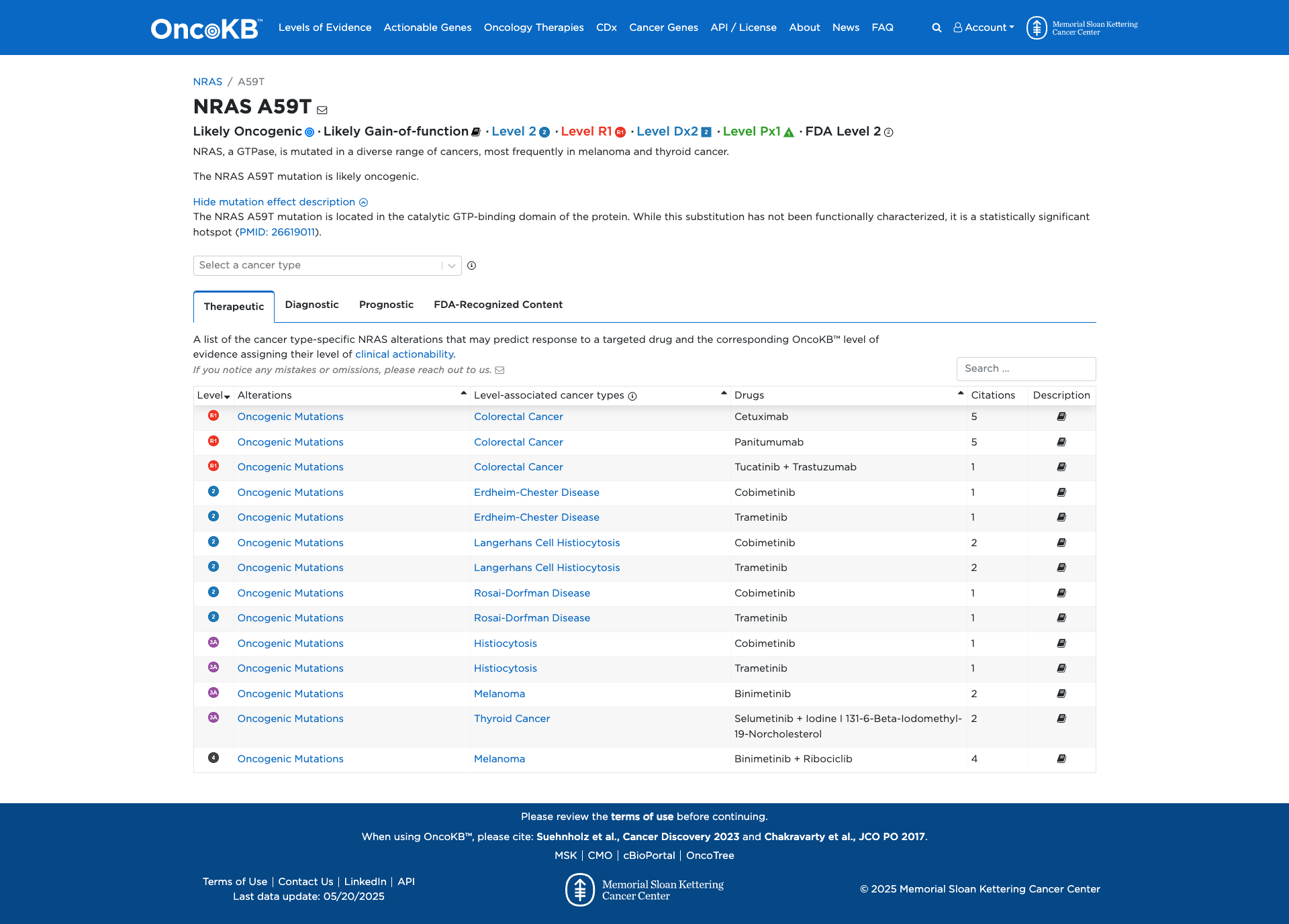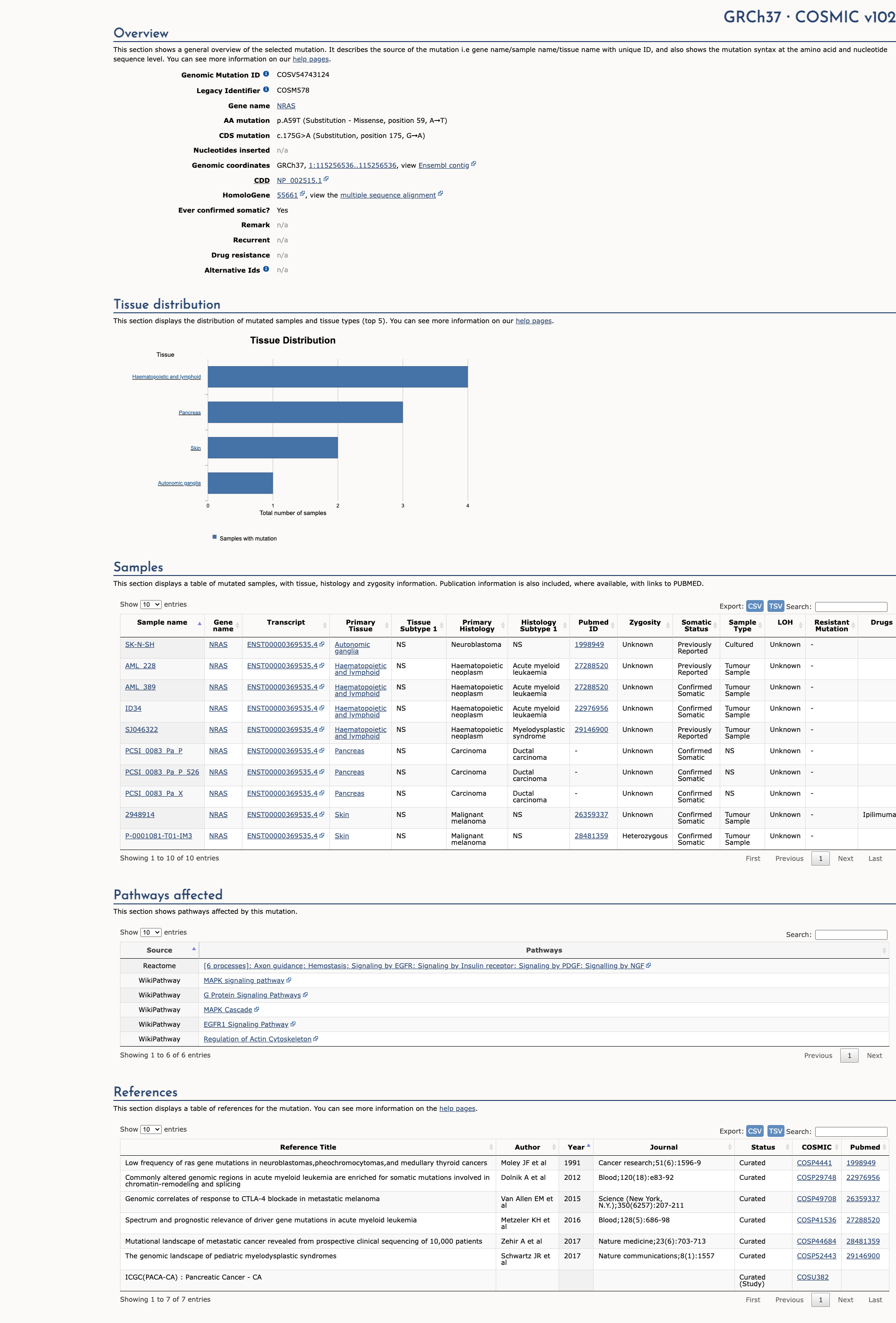NRAS c.175G>A, p.Ala59Thr
NM_002524.4:c.175G>A
COSMIC ID: COSM578
Likely Pathogenic
This variant (NRAS A59T) lies in a known functional domain (SW2), is absent from controls, has in silico deleterious predictions, and occurs at a residue with other pathogenic substitutions. Together, 2 Moderate (PM1, PM5) and 2 Supporting (PM2, PP3, PP5) criteria support a Likely Pathogenic classification.
ACMG/AMP Criteria Applied
PM1
PM2
PM5
PP3
PP5
Genetic Information
Gene & Transcript Details
Gene
NRAS
Transcript
NM_002524.5
MANE Select
Total Exons
7
Strand
Reverse (−)
Reference Sequence
NC_000001.10
Alternative Transcripts
| ID | Status | Details |
|---|---|---|
| NM_002524.3 | Alternative | 7 exons | Reverse |
| NM_002524.2 | Alternative | 7 exons | Reverse |
| NM_002524.4 | Alternative | 7 exons | Reverse |
Variant Details
HGVS Notation
NM_002524.4:c.175G>A
Protein Change
A59T
Location
Exon 3
(Exon 3 of 7)
5'Exon Structure (7 total)3'
Functional Consequence
Loss of Function
Related Variants
ClinVar reports other pathogenic variants at position 59: A59D
Alternate Identifiers
COSM578
Variant interpretation based on transcript NM_002524.5
Genome Browser
Loading genome browser...
HGVS InputNM_002524:c.175G>A
Active Tracks
ConservationRefSeqClinVargnomAD
Navigation tips: Use mouse to drag and zoom. Click on features for details.
Clinical Data
Population Frequency
Global Frequency
0.0 in 100,000
Extremely Rare
Global: 0.0%
0%
0.05%
0.1%
1%
5%
10%+
ACMG Criteria Applied
PM2
This variant is not present in gnomAD (PM2 criteria applies).
Classification
2 publications
Likely Pathogenic
Based on 4 submitter reviews in ClinVar
Submitter Breakdown
1 Path
2 LP
1 VUS
Pathogenic
Likely Path.
VUS
Likely Benign
Benign
Publications (2)
Based on the classification scheme VCGS_Germline_v0.6.1, this variant is classified as Pathogenic. Following criteria are met: 0101 - Gain of function is a known mechanism of disease for this gene. (N) 0107 - This gene is known to be associated with autosomal dominant disease. (N) 0200 - Variant is predicted to result in a missense amino acid change from alanine to threonine (exon 3). (N) 0301 - Variant is absent from gnomAD. (P) 0501 - Missense variant consistently predicted to be damaging by in silico tools or highly conserved with a major amino acid change. (P) 0600 - Variant is located in an annotated domain or motif that does not have a well established function (switch II functional domain; PMID: 28594414). (N) 0602 - Variant affects known somatic hotspot region or cluster of pathogenic variants. However, germline variants on the somatic hotspots have been reported to cause Noonan (PMID: 28594414). (P) 0705 - No comparable variants in relevant codon/region have previous evidence for pathogenicity. (N) 0803 - Low previous evidence of pathogenicity in unrelated individuals. This variant has been reported likely pathogenic once (ClinVar). (P) 0905 - No published segregation evidence has been identified for this variant. (N) 1007 - No published functional evidence has been identified for this variant. (N) 1204 - De Novo Variant (Parental status not tested but assumed). (P) Legend: (P) - Pathogenic, (N) - Neutral, (B) - Benign
The variant is not observed in the gnomAD v2.1.1 dataset. Predicted Consequence/Location: Missense changes are a common disease-causing mechanism. In silico tool predictions suggest damaging effect of the variant on gene or gene product (REVEL: 0.87; 3Cnet: 0.99). Same nucleotide change resulting in same amino acid change has been previously reported as pathogenic/likely pathogenic with strong evidence (ClinVar ID: VCV000040473). A different missense change at the same codon (p.Ala59Asp) has been reported to be associated with NRAS related disorder (ClinVar ID: VCV000812886 /PMID: 32581362). Therefore, this variant is classified as Likely pathogenic according to the recommendation of ACMG/AMP guideline.
Clinical Statement
This variant has been reported in ClinVar as Likely pathogenic (2 clinical laboratories) and as Uncertain significance (1 clinical laboratories) and as Pathogenic (1 clinical laboratories).
Functional Impact
Functional Domain
Hotspot Status
Not a hotspot
Domain Summary
This variant is not located in a mutational hotspot or critical domain (0 mutations).
Related Variants in This Domain
ClinVar reports other pathogenic variants at position 59: A59D
PM5 criterion applied.
Functional Summary
The NRAS A59T variant has not been directly functionally characterized. However, it is predicted to lead to a gain of function based on its location in the GTP-binding domain and by analogy to the HRAS A59T variant, which is known to increase nucleotide exchange rate and transform cultured cells.
Database Previews
OncoKB

JAX-CKB

Click on previews to view full database entries. External databases may require institutional access.
Computational Analysis
Pathogenicity Predictions
REVEL Score
0.873
0.873
Likely Benign0.0
Uncertain (Low)0.2
Uncertain (Med)0.5
Likely Pathogenic0.75
REVEL scores ≥ 0.75 are strong evidence (PP3)
Predictor Consensus
Mixed/VUS
PP3 Applied
Yes
Additional Predictors
Benign:
CADD: 5.09
VCEP Guidelines
Applied ACMG/AMP Criteria (VCEP Specific) VCEP Guidelines
PVS1
PVS1 (Not Applied) Strength Modified
According to standard ACMG guidelines, PVS1 is: 'Null variant (nonsense, frameshift, canonical ±1 or 2 splice sites, initiation codon, single or multi‐exon deletion) in a gene where loss of function is a known mechanism of disease.' The evidence for this variant shows it is a missense change (A59T) in NRAS, and gain‐of‐function, not loss‐of‐function, is the disease mechanism. Therefore, this criterion is not applied.
PS1
PS1 (Not Applied) Strength Modified
According to VCEP guidelines, the rule for PS1 is: 'Strong Same amino acid change as a previously established pathogenic variant regardless of nucleotide change.' The evidence for this variant shows no different nucleotide change yielding the same A59T amino acid substitution has been reported as pathogenic. Therefore, this criterion is not applied.
PS2
PS2 (Not Applied) Strength Modified
According to standard ACMG guidelines, PS2 is: 'De novo (both maternity and paternity confirmed) in a patient with the disease and no family history.' The evidence for this variant shows no parental genotype data to assess de novo occurrence. Therefore, this criterion is not applied.
PS3
PS3 (Not Applied) Strength Modified
According to VCEP guidelines, PS3 is: 'Moderate Two or more different approved assays or Supporting One approved assay demonstrating a deleterious effect.' The evidence for this variant shows no direct functional assay data; predictions by analogy do not meet the VCEP requirement for approved assays. Therefore, this criterion is not applied.
PS4
PS4 (Not Applied) Strength Modified
According to standard ACMG guidelines, PS4 is: 'The prevalence of the variant in affected individuals is significantly increased compared with controls.' The evidence for this variant shows no case‐control or proband frequency data. Therefore, this criterion is not applied.
PM1
PM1 (Moderate)
According to VCEP guidelines, PM1 is: 'Moderate Applicable only to critical and well‐established functional domains (SW2 [AA 57-64]).' The evidence for this variant shows A59T lies within the SW2 domain (AA 57-64) of NRAS. Therefore, this criterion is applied at Moderate strength.
PM2
PM2 (Supporting) Strength Modified
According to VCEP guidelines, PM2 is: 'Supporting The variant must be absent from controls (gnomAD).' The evidence for this variant shows it is absent from population databases (gnomAD MAF=0%). Therefore, this criterion is applied at Supporting strength.
PM3
PM3 (Not Applied) Strength Modified
According to standard ACMG guidelines, PM3 is: 'For recessive disorders, detected in trans with a pathogenic variant.' The evidence for this variant shows no recessive inheritance or trans observations. Therefore, this criterion is not applied.
PM4
PM4 (Not Applied) Strength Modified
According to standard ACMG guidelines, PM4 is: 'Protein length changes due to in‐frame deletions/insertions or stops in non‐repetitive region.' The evidence for this variant shows it is a single amino acid substitution without length change. Therefore, this criterion is not applied.
PM5
PM5 (Moderate)
According to VCEP guidelines, PM5 is: 'Moderate 1 likely pathogenic residue change at the same codon.' The evidence for this variant shows a novel A59T change at a codon where other missense changes (e.g., A59G) have been determined pathogenic. Therefore, this criterion is applied at Moderate strength.
PM6
PM6 (Not Applied) Strength Modified
According to standard ACMG guidelines, PM6 is: 'Assumed de novo, without confirmation of paternity and maternity.' The evidence for this variant shows no parental data. Therefore, this criterion is not applied.
PP1
PP1 (Not Applied) Strength Modified
According to VCEP guidelines, PP1 is: 'Supporting Segregation in ≥3 affected family members.' The evidence for this variant shows no segregation data. Therefore, this criterion is not applied.
PP2
PP2 (Not Applied) Strength Modified
According to standard ACMG guidelines, PP2 is: 'Missense variant in a gene with low rate of benign missense variation where missense is a common mechanism.' The evidence for this variant lacks quantitative data on benign missense rates for NRAS. Therefore, this criterion is not applied.
PP3
PP3 (Supporting)
According to VCEP guidelines, PP3 is: 'Supporting For missense variants: REVEL ≥0.7.' The evidence for this variant shows REVEL score=0.87, exceeding the threshold. Therefore, this criterion is applied at Supporting strength.
PP4
PP4 (Not Applied) Strength Modified
According to standard ACMG guidelines, PP4 is: 'Patient’s phenotype or family history is highly specific for a disease with a single genetic etiology.' The evidence for this variant shows no detailed phenotype correlation. Therefore, this criterion is not applied.
PP5
PP5 (Supporting)
According to standard ACMG guidelines, PP5 is: 'Reputable source reports variant as pathogenic, but evidence not available for independent evaluation.' The evidence for this variant shows ClinVar entries from multiple laboratories reporting likely pathogenic or pathogenic. Therefore, this criterion is applied at Supporting strength.
BA1
BA1 (Not Applied) Strength Modified
According to VCEP guidelines, BA1 is: 'Stand Alone GnomAD filtering allele frequency ≥0.05%.' The evidence for this variant shows MAF=0% in gnomAD. Therefore, this criterion is not applied.
BS1
BS1 (Not Applied) Strength Modified
According to VCEP guidelines, BS1 is: 'Strong GnomAD filtering allele frequency ≥0.025%.' The evidence for this variant shows MAF=0% in gnomAD. Therefore, this criterion is not applied.
BS2
BS2 (Not Applied) Strength Modified
According to standard ACMG guidelines, BS2 is: 'Observed in a healthy adult with full penetrance expected at an early age.' The evidence for this variant shows no observations in healthy individuals. Therefore, this criterion is not applied.
BS3
BS3 (Not Applied) Strength Modified
According to standard ACMG guidelines, BS3 is: 'Well‐established functional studies show no damaging effect.' The evidence for this variant shows no functional assays demonstrating neutrality. Therefore, this criterion is not applied.
BS4
BS4 (Not Applied) Strength Modified
According to standard ACMG guidelines, BS4 is: 'Lack of segregation in affected members of a family.' The evidence for this variant shows no family segregation studies. Therefore, this criterion is not applied.
BP1
BP1 (Not Applied) Strength Modified
According to VCEP guidelines, BP1 is contraindicated for RASopathies as truncating variants are irrelevant; this is a missense variant. Therefore, this criterion is not applied.
BP2
BP2 (Not Applied) Strength Modified
According to standard ACMG guidelines, BP2 is: 'Observed in trans with a pathogenic variant for a fully penetrant dominant gene.' The evidence for this variant shows no such observation. Therefore, this criterion is not applied.
BP3
BP3 (Not Applied) Strength Modified
According to standard ACMG guidelines, BP3 is: 'In‐frame indels in repetitive regions without functional impact.' The evidence for this variant shows it is a missense change, not an indel. Therefore, this criterion is not applied.
BP4
BP4 (Not Applied) Strength Modified
According to VCEP guidelines, BP4 is: 'Supporting For missense variants: REVEL ≤0.3.' The evidence for this variant shows REVEL score=0.87. Therefore, this criterion is not applied.
BP5
BP5 (Not Applied) Strength Modified
According to standard ACMG guidelines, BP5 is: 'Variant found in a case with an alternate molecular basis for disease.' The evidence for this variant shows no alternate molecular explanation. Therefore, this criterion is not applied.
BP6
BP6 (Not Applied) Strength Modified
According to standard ACMG guidelines, BP6 is: 'Reputable source reports variant as benign, but evidence not available.' The evidence for this variant shows no such benign reports. Therefore, this criterion is not applied.
BP7
BP7 (Not Applied) Strength Modified
According to standard ACMG guidelines, BP7 is: 'Synonymous variant with no predicted splice impact and nucleotide not conserved.' The evidence for this variant shows it is a missense change. Therefore, this criterion is not applied.

